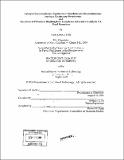Catalytic enantioselective synthesis of oxindoles and benzofuranones bearing a quaternary stereocenter and reactions of palladium bisphosphine complexes relevant to catalytic C-C bond formation
Author(s)
Hills, Ivory Derrick, 1977-
DownloadFull printable version (11.00Mb)
Alternative title
Reactions of palladium bisphosphine complexes relevant to catalytic C-C bond formation
Other Contributors
Massachusetts Institute of Technology. Dept. of Chemistry.
Advisor
Gregory C. Fu.
Terms of use
Metadata
Show full item recordAbstract
In Part I the development of a new method for the construction of oxindoles and benzofuranones bearing quaternary stereocenters is discussed. A planar-chiral PPY derivative catalyzes the O-to-C acyl group migration (Black rearrangement) in a highly efficient and enantioselective manner. The utility of this method is further demonstrated by the formal total synthesis of the natural product aplysin. In Part II reactivity of bisphosphine palladium-complexes is discussed. It is shown that the oxidative addition of bisphosphine palladium-complexes bearing P(t-Bu₂)Me occurs through an SN2-type mechanism. This discovery allows us rationalize the difference in catalytic activity between Pd(P(t-Bu₂)Me)₂ and Pd(P(t-Bu₂)Et)₂ for the cross-coupling of alkyl electrophiles. The reductive elimination of H-X from bisphosphine palladium-hydride complexes is also discussed. The discovery that (P(t-Bu)₃)₂PdHCl undergoes facile reductive elimination in the presence of Cy₂NMe, while (PCy₃)₂PdHCl does not, is explained using X-ray crystal structures. These reactivity patterns may help to explain why Pd(P(t-Bu)₃)₂ is a much better catalyst than Pd(PCy₃)₂ for the Heck coupling of aryl chlorides. Finally, Part III describes preliminary work on a palladium-hydride catalyzed isomerization of allylic alcohols as well as initial attempts to study the mechanism of nickel-catalyzed cross-couplings of secondary alkyl-electrophiles.
Description
Thesis (Ph. D.)--Massachusetts Institute of Technology, Dept. of Chemistry, 2004. Includes bibliographical references.
Date issued
2004Department
Massachusetts Institute of Technology. Department of ChemistryPublisher
Massachusetts Institute of Technology
Keywords
Chemistry.